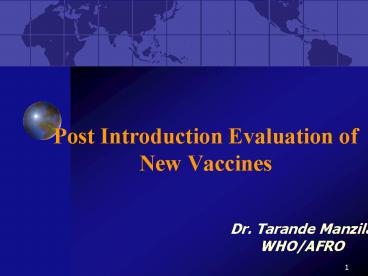Post Introduction Evaluation of New Vaccines - PowerPoint PPT Presentation
1 / 18
Title:
Post Introduction Evaluation of New Vaccines
Description:
Timing has been tailored to the country need: ... PIE proved to be a useful excercise in the early stage of NV intro in the region ... – PowerPoint PPT presentation
Number of Views:153
Avg rating:3.0/5.0
Title: Post Introduction Evaluation of New Vaccines
1
Post Introduction Evaluation of New Vaccines
Dr. Tarande Manzila WHO/AFRO
2
Historical perspectives
- No reliable documentation of new vaccine
introduction in early introducing countries
(Botswana, Zimbabwe, Swaziland, South Africa, The
Gambia)
3
Why PIE in AFRO
- Lack of regional reference
- Absence of documentation on experience of
earlier countries - Limited technical assistance to countries
- during preparation for introduction
- Result of observation of early assessment
4
Objective
- The overall objective is to document the
process of integrating a new vaccine into EPI
programmes
5
Specific objectives
- Specific Objectives
- Document the process of introduction
- Assess introductions impact on the
- programme
- Identify challenges and constrains and define
ways of overcoming them
6
PIE Audiences
- The country itself and its partners PIE aims at
improving the introduction process and to achieve
the goals set while providing the country with
written references of what exactly happened - Other countries introducing or that may do so in
future apply lessons learnt from other countries
7
Methodology
- Terms of reference created
- District sampling for field visits (attempts made
to select representative sample of the country
districts for the evaluation) - Evaluation tool (use of standardize questionnaire
for various levels Central, Province,
district/health facility). - Individual interviews
- Exit interviews with caretakers
- Observation of immunization session, the
environment, cold chain system, vaccine
management, injection safety, wastage management
etc.
8
Sequence of events leading to the PIE
- EPI review
- National plan for new vaccine introduction
- Vaccine fund application submitted
- New vaccine Introduced
- Early assessment in some cases
- PIE
9
Timing of the evaluation
- Timing has been tailored to the country need
- If too closed, findings may be cluttered with
short-live operational issues that will not have
lasting effect on the program - If too late, the program may lose the ability to
detect problems early enough to allow prompt
corrective action - Lost of memory - Recommend time between is 8 to 18 months
following introduction
10
Similarities with other EPI reviews
- Address the 5 functions of immunization services
- Evaluate all levels of the health care system
- Select representative sample of the health system
- Opportunity to follow-up on recommendations of
previous EPI reviews
11
Comparative advantages
- Small teams
- Limited time
- No extensive data analysis
- Qualitative process description
- Inexpensive 3000-4000 (local expenses)
- Possible link with disease surveillance (Hib,
Yellow Fever)
12
ExampleBenin (9th month)
- Health facilities using all types of syringes
and needles (ADs, standard and sterilizables) - No national policy on injection safety
- Very weak/non-functioning ICC
- HepB introduced with catch-up, up to 2 years of
age, risk of vaccine shortage - Fear of vaccine wastage causing low coverage
- Lack knowledge of appropriate storage temperature
for HepB vaccine
13
ExamplesEritrea (10th month)
- Inability of health workers to forecast vaccine
and supply needs - The absence of monitoring system for drop outs
and vaccine wastage - Inappropriate storage temperatures even at
regional level
14
ExampleMozambique
- There were 200,000 doses of DTP still in one
provincial cold store - Has two columns of wastages, but only on the
monthly reporting forms - All vaccines frozen in one district cold store
15
ExampleTanzania
- The implementation of MVP instituted, with
- reduction vaccine wastage
- Defective BCG syringes discovered and
- supply discontinued
- Authorities aaproved to consider Hib vaccine
introduction
16
Conclusion
- PIE proved to be a useful excercise in the early
stage of NV intro in the region - Process documentation of new vaccine introduction
now available in most countries - PIE is limited,focused and cost effective
- Provides an opportunity for supportive
supervision. - PIE provides an opportunity to follow up on
recommendation of previous reviews - Tool Has the potential to be expanded or
integrated with other evaluations - Lack of dry storage in most countries
17
Way forward for PIE
- PIE tool could be expanded to include other EPI
assessment tools (MNT risk assessment, vehicle,
etc) - It is possible to combine PIE with the rapid EPI
assessment tool used in southern Africa or with
formal EPI reviews
18
Thank you!































